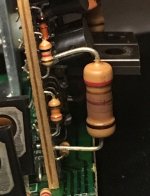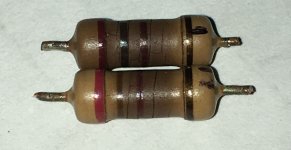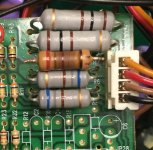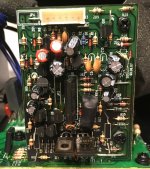Hi all!
I'm reviving this issue from this post... Dayton SPA250 Plate Amplifier repair help
The SPA250 is a very popular subwoofer plate amplifier. Unfortunately, almost everyone seems to eventually get the dreaded "popping" sounds after some time. I've been plagued with this issue for quite some time now. Happens every day, multiple times, but hasn't really gotten any worse. I decided to take a look at the amplifier and found the same suspect over-heated resistors that everyone talks about on the "soft-limit" pcb. After looking at all the boards, I found no other over-heated parts. Guess I'm lucky! It's a tough call as to what the original color bands were. However, a posts in the original thread mentioned above show that the resistors might be 2.4k ohms. Reading through the posts shows a picture of this resistor on a newer amplifier from 2016, stating that the resistor is now 3k ohms. That color code would be Orange-Black-Red. Really hard to tell EXACTLY what the bands on my overheated resistors are! However, after measuring the resistors, both in and out of the pcb, each one shows almost exactly 2.4k ohms. If this is the original value, they have both only overheated and, so far, have not caused any other damage.
Also note the picture of the burnt resistor laying in-between the other resistors on the INPUT pcb for comparison. I believe these overheated resistors are 2w? If so, I'm going to go with 3w metal-film resistors. I believe the larger resistor above my resistor is a 3w?
I can get these resistors in 2.4k, 2.7k and 3k, all in a 3 watt metal film version. My plan is to mechanically attach and solder the new resistors to the existing leads I left intact from the original over-heated resistors. Thoughts?
Sorry for the long diatribe, but felt I needed to convey what's going on.
I'd like to repair this amp, as it's from my original Titanic Mk III 10" subwoofer. The included box was cut specifically for the SPA240/250 plate amplifiers and nothing else will fit!
Thanks everyone!
I'm reviving this issue from this post... Dayton SPA250 Plate Amplifier repair help
The SPA250 is a very popular subwoofer plate amplifier. Unfortunately, almost everyone seems to eventually get the dreaded "popping" sounds after some time. I've been plagued with this issue for quite some time now. Happens every day, multiple times, but hasn't really gotten any worse. I decided to take a look at the amplifier and found the same suspect over-heated resistors that everyone talks about on the "soft-limit" pcb. After looking at all the boards, I found no other over-heated parts. Guess I'm lucky! It's a tough call as to what the original color bands were. However, a posts in the original thread mentioned above show that the resistors might be 2.4k ohms. Reading through the posts shows a picture of this resistor on a newer amplifier from 2016, stating that the resistor is now 3k ohms. That color code would be Orange-Black-Red. Really hard to tell EXACTLY what the bands on my overheated resistors are! However, after measuring the resistors, both in and out of the pcb, each one shows almost exactly 2.4k ohms. If this is the original value, they have both only overheated and, so far, have not caused any other damage.
Also note the picture of the burnt resistor laying in-between the other resistors on the INPUT pcb for comparison. I believe these overheated resistors are 2w? If so, I'm going to go with 3w metal-film resistors. I believe the larger resistor above my resistor is a 3w?
I can get these resistors in 2.4k, 2.7k and 3k, all in a 3 watt metal film version. My plan is to mechanically attach and solder the new resistors to the existing leads I left intact from the original over-heated resistors. Thoughts?
Sorry for the long diatribe, but felt I needed to convey what's going on.
I'd like to repair this amp, as it's from my original Titanic Mk III 10" subwoofer. The included box was cut specifically for the SPA240/250 plate amplifiers and nothing else will fit!
Thanks everyone!
Attachments
Last edited:
Your photo shows two 680R and two 100R a schematic that reflects at least the same values would be useful.
But, replacing resistors with larger power ratings might be of no benefit until you find out why the get hot in the first place. It may be poor ventilation, in which case a 100W resistor will only last a bit longer before it burns the board.
But, replacing resistors with larger power ratings might be of no benefit until you find out why the get hot in the first place. It may be poor ventilation, in which case a 100W resistor will only last a bit longer before it burns the board.
- Status
- Not open for further replies.



